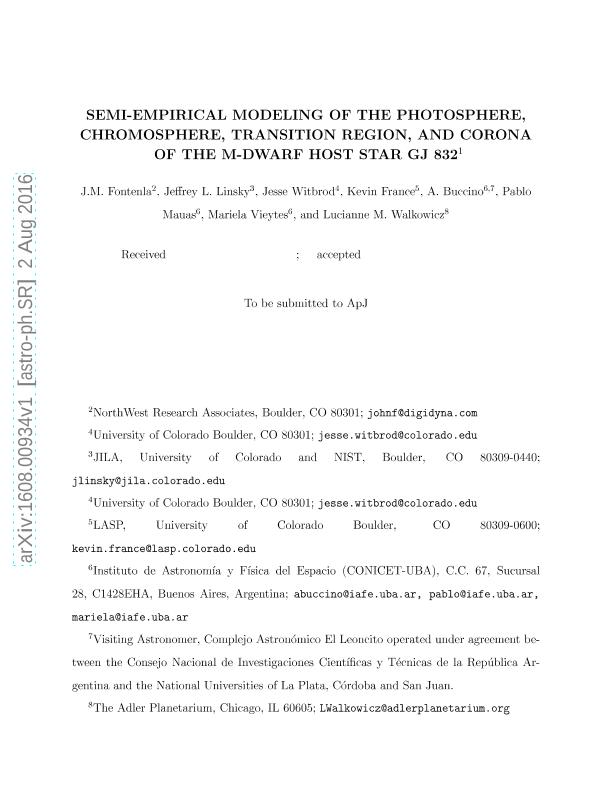Artículo
Semi-empirical Modeling of the Photosphere, Chromosphere, Transition Region, and Corona of the M-dwarf Host Star GJ 832
Fontenla, J. M.; Linsky, J. L.; Witbrod, J.; France, K.; Buccino, Andrea Paola ; Mauas, Pablo Jacobo David
; Mauas, Pablo Jacobo David ; Vieytes, Mariela Cristina
; Vieytes, Mariela Cristina ; Walkowicz, L.
; Walkowicz, L.
 ; Mauas, Pablo Jacobo David
; Mauas, Pablo Jacobo David ; Vieytes, Mariela Cristina
; Vieytes, Mariela Cristina ; Walkowicz, L.
; Walkowicz, L.
Fecha de publicación:
10/2016
Editorial:
IOP Publishing
Revista:
Astrophysical Journal
ISSN:
0004-637X
Idioma:
Inglés
Tipo de recurso:
Artículo publicado
Clasificación temática:
Resumen
Stellar radiation from X-rays to the visible provides the energy thatcontrols the photochemistry and mass loss from exoplanet atmospheres.The important extreme ultraviolet (EUV) region (10-91.2 nm) isinaccessible and should be computed from a reliable stellar model. It isessential to understand the formation regions and physical processesresponsible for the various stellar emission features to predict how thespectral energy distribution varies with age and activity levels. Wecompute a state-of-the-art semi-empirical atmospheric model and theemergent high-resolution synthetic spectrum of the moderately active M2V star GJ 832 as the first of a series of models for stars withdifferent activity levels. We construct a one-dimensional simple modelfor the physical structure of the star?s chromosphere,chromosphere-corona transition region, and corona using non-LTEradiative transfer techniques and many molecular lines. The synthesizedspectrum for this model fits the continuum and lines across theUV-to-optical spectrum. Particular emphasis is given to the emissionlines at wavelengths that are shorter than 300 nm observed with theHubble Space Telescope, which have important effects on thephotochemistry of the exoplanet atmospheres. The FUV line ratiosindicate that the transition region of GJ 832 is more biased to hottermaterial than that of the quiet Sun. The excellent agreement of ourcomputed EUV luminosity with that obtained by two other techniquesindicates that our model predicts reliable EUV emission from GJ 832. Wefind that the unobserved EUV flux of GJ 832, which heats the outeratmospheres of exoplanets and drives their mass loss, is comparable tothe active Sun.
Archivos asociados
Licencia
Identificadores
Colecciones
Articulos(IAFE)
Articulos de INST.DE ASTRONOMIA Y FISICA DEL ESPACIO(I)
Articulos de INST.DE ASTRONOMIA Y FISICA DEL ESPACIO(I)
Citación
Fontenla, J. M.; Linsky, J. L.; Witbrod, J.; France, K.; Buccino, Andrea Paola; et al.; Semi-empirical Modeling of the Photosphere, Chromosphere, Transition Region, and Corona of the M-dwarf Host Star GJ 832; IOP Publishing; Astrophysical Journal; 830; 2; 10-2016; 154,1-18
Compartir
Altmétricas



